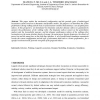Free Online Productivity Tools
i2Speak
i2Symbol
i2OCR
iTex2Img
iWeb2Print
iWeb2Shot
i2Type
iPdf2Split
iPdf2Merge
i2Bopomofo
i2Arabic
i2Style
i2Image
i2PDF
iLatex2Rtf
Sci2ools
ROBOTICA
2008
2008
Kinematic and dynamic performance analysis of artificial legged systems
This paper studies the mechanical configuration and the periodic gaits of multi-legged locomotion systems based on its kinematic and dynamic models. The purpose is to determine the system performance during walking and the best set of locomotion variables that minimize a set of optimization indices. In this perspective, are formulated two kinematic and four dynamic indices to quantitatively measure the performance of the walking robot. The kinematic indices consist on the perturbation analysis and the locomobility measure, and the dynamic performance indices of the walking robot locomotion are the mean absolute density of energy, the mean power density dispersion, the density of power lost and the mean force at the body-legs interface. A set of model-based simulation experiments reveals the system configuration and the type of movements that lead to a better performance, for a specific locomotion mode, from the viewpoint of the proposed indices.
Related Content
| Added | 28 Dec 2010 |
| Updated | 28 Dec 2010 |
| Type | Journal |
| Year | 2008 |
| Where | ROBOTICA |
| Authors | Manuel F. Silva, José António Tenreiro Machado |
Comments (0)

